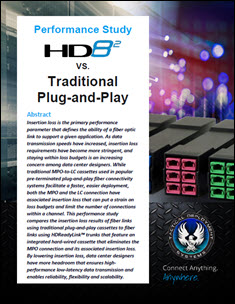A new white paper from Tactical Deployment Systems compares the insertion loss of HD8² to traditional plug-and-play fiber connectivity. Insertion loss is one of the primary issues data centers face when using MPO-to-LC cassettes, according to the report. With their white paper, Tactical Deployment Systems sets out to prove that eliminating the MPO connection with an integrated hard-wired cassette will significantly reduce the insertion loss found in the traditional setup.
While pre-terminated plug-and-play fiber connectivity solutions are commonly used in data centers, the associated insertion loss can “put a strain on loss budgets and limit the number of connections within a channel.” The report goes on to say that “while fiber cable and connectivity manufacturers have managed to significantly reduce insertion loss performance over the past decade, loss budgets still remain a number one concern among data center designers.”
The paper begins by examining the performance of traditional MPO-to-LC cassettes and how insertion loss is compounded with the introduction of cross connects. Add in other loss events like macrobends and dirty fiber ends, and the losses could be 2.48 db, which exceeds the stringent requirements of higher speed applications.
As counterpoint, Tactical Deployment Systems presents the loss insertion performance data of their HD8² High Density Fiber System. This proprietary system hard wires the trunk cable to the duplex connectors, resulting in a significant reduction in insertion loss. While the square cartridge is smaller in design than traditional cartridges, it offers increased capacity, according to the paper.
“By lowering insertion loss, data center designers have more headroom that ensures high-performance low-latency data transmission and enables reliability, flexibility and scalability.” Tactical Deployment Systems, “Performance Study HD8² VS. Traditional Plug-and-Play“
To conduct the performance study, Tactical Deployment Systems “used Tier 1 testing to compare insertion loss of a leading manufacturer’s traditional plug-and-play system to the HD8² system using HDReadyLink
The paper conclude that the elimination of the MPO connection and performance improvements of the HD8² system offer “significant improvement in both insertion loss performance and density.”
Get the full report “Performance Study HD8² VS. Traditional Plug-and-Play” from Tactical Deployment Systems to examine the data.








where can i buy hemp inc stock